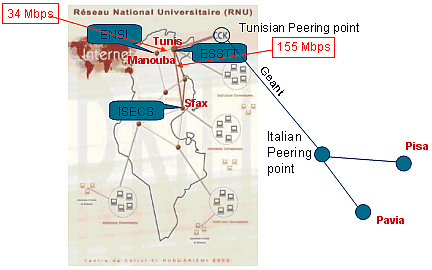Software and Communication Platforms for High-Performance Collaborative Grid
Specific purposes
The focus in this project is on the creation of a joint laboratory for the engineering of collaborative grids both at the application level and at the infrastructure (network) level. The activity of the project is divided in three phases on enabling solutions (Workpackage 1), integration of enabling solutions (Workpackage 2) and joint experiments among the research units (workpackage 3). We also propose to organize joint working sessions within the project to test the solutions developed in the laboratories both as research objective and as a collaborative working tool.
Here is the scheme of the network connecting Tunisian and Italian laboratories:

At the infrastructure level, the proposed research activity gives an answer
to the increased request of bandwidth by terminals for the access to special
and multimedia services and/or for high speed Internet access. In particular,
access networks should be granted an efficient packet transport far beyond
the access segment. The natural geographic aggregation of the users that are
served by the same access node finds, in optical transport network, a protocol
counterpart in the MPLS (Multi-protocol Label switching) technique.
These research units envision investigations on the optical metro/core network
segments for the efficient support of multimedia application. In particular we
plan to investigate traffic engineering and QoS support for both the metropolitan
and core network. In the metro segment provisioning and resilience schemes
operating through IP/MPLS protocols and with transmission rate of the order
of a Gigabit per second will be investigated. In the core networks a suitable
integration of metro segments will be studied to support end-to-end QoS via
proper mapping of virtual circuit using the GMPLS protocol suite.
At the device level the problems arising from the creation of highly reconfigurable optical networks will be addressed. A class of new devices employing micro-structured materials will be investigated. In particular the attention will be concentrated on the optimization of their optical properties through an appropriate fabrication process. This may include the introduction of carefully selected and controlled dopants in the crystal matrix, or the cross-section engineering of micro-structured optical fibers.
At the application level, developments in ICTs have a significant impact on
conventional and non-conventional higher education. Current System-User
interfaces based on the WIMP (Windows, Icons, Menus and Pointing device)
paradigm will almost surely not scale effectively to match all future
applications, requiring more sophisticated and “natural” interaction, where
the interaction with the computer will be able to exploit the perceptive
abilities of human-human communication. Multimedia components are already
included in current interfaces; much research effort is anyway still necessary
to assess the effectiveness of different media and their integrated use in a
virtual learning environment.
In perspective, future developments of natural interactivity will possibly
include multi-dimensional interfaces (able to provide 1D/2D/3D/nD metaphors)
and perceptive interfaces (able to acquire explicit and implicit information
about users and the environment in which they operate). In the context of
multi-dimensional interfaces, though research is already showing that a proper
use of visual metaphors can impact computer-mediated experiences, yet significant
research efforts are needed to assess the value of different dimensional metaphors,
their possible integration, and their individual and combined effect on learning
outcomes.
To enhance the quality of the interaction, and make it more natural, we
will also experiment the integration of perceptive interfaces within e-learning
systems. Perceptive interfaces provide the computer with “sensitive” capabilities
typical of human-human communication, so that the interface becomes able
to “see”, “hear”, etc. Vision-based user interfaces (VBIs), which acquire data
input through cameras, represent an important part of this category. New
e-learning interfaces based on gesture recognition, head tracking, and eye
tracking could surely enhance the quality of interaction (e.g. by adapting the
interface according to those elements which are the most looked at by the user,
or by recognizing specific gestures and head movements as input commands, which
would be especially useful for disabled users). Moreover, facial expression
recognition may represent one of the most exciting research directions, towards
more natural ways of interacting with the e-learning environment: by interpreting
the user’s emotional status, the system could change its behaviour accordingly.
For instance, from the fact that the user is knitting the eyebrows the computer
could infer that something is not clear and automatically open a help window.
The use of VBIs techniques can be considered a relatively new approach for
user interaction with virtual environments within e-learning systems, and
can open new possibilities for more effective communication modalities.
Although this is especially true for people with disabilities that prevent
normal use of the hands (who, this way, would become able to accomplish
tasks that so far have been unattainable for them), VBIs techniques can be
also conveniently applied to general situations.
Gesture recognition can be exploited to allow people to communicate with
real and virtual devices without the need for touching them. Head tracking
has the main advantage of freeing, totally or partially, the user’s hands
and can be used to implement some forms of communication driven by the
position/movement of the head. Eye tracking, at last, can be exploited in
more sophisticated interaction modes where the exact identification of the
user’s gaze is required (e.g. for pointing tasks, or for understanding
whether the user is reading).
Another goal of the research is to enrich Learning Management Systems with
pedagogical tools to ameliorate the quality of education process. Today,
many implementations and experimentations have been done. This experimentations
show that technological tools do not guarantee their success unless the
pedagogical aspect is not considered.

